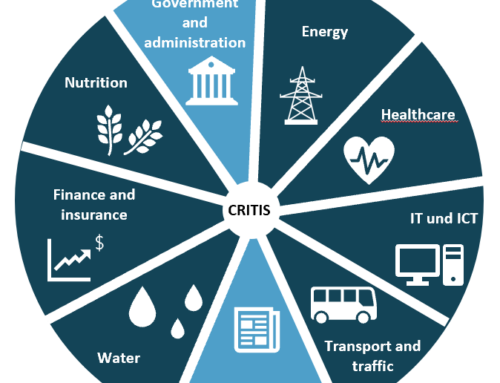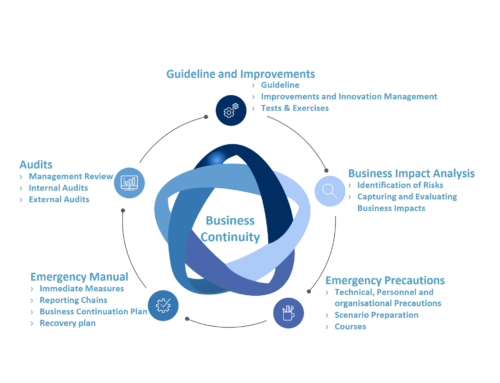Business continuity management can also mean “emergency and crisis management”. We also find this term in the administrative sector, as in the work of civil protection. But is leadership in the event of crises really the same? This short article is intended to highlight individual differences and similarities between these two emergency and crisis management approaches so that a distinction can be made and differentiation simplified.
Causes of crises
The causes of crises or disasters in the field of civil protection are almost exclusively external. This means, for example, natural disasters, terrorist attacks or a technical/human failure, which leads to high risks. In the case of companies, there are two additional causes: inadequate attention to operational fluctuations up to the point of escalation and the occurrence of latent problems, which lead to high reputational damage. The crisis is therefore not only brought in from the outside, but may also have been caused by the company itself.
Protection goals or priorities
In the area of administrative crisis management, the protection of human life or the impairment of people’s health are the main priorities. This is, of course, due to the fact that administrative emergency response is always called into action when life and health are actually at risk. In companies, the focus is also on protecting employees if they are endangered by an event. However, this protection is not aimed purely at preserving health, but is an essential part of protecting against reputational and financial damage. For if, for example, it is proven that people have been harmed as a result of inadequate protective devices, the company’s reputation will decline and this will subsequently lead to a loss of financial income. If a crisis occurs, the needs/demands of customers must be considered and require a lot of attention. A company must therefore take into account a wide variety of stakeholders in order to prevent far-reaching damage.
In general, reputation and monetary aspects are always two of the most important protection goals for companies. BCM always has the continued existence of its own company as its goal. In the corporate sector, adequate handling of crises can prevent damage to the company’s image and minimize the financial impact. In the area of civil protection, on the other hand, money plays a subordinate role. A management team can often draw on its full resources and does not have to think about loss of earnings due to, for example, the shutdown of a production line. Damage to reputation can occur here as well (mostly to the detriment of political actors), but this rarely has an immediate impact on continued existence. Administrative emergency response is not responsible for restarting business operations and usually ends operations after a threat has been averted or its impact has been limited. However, a company may want to resume operations as soon as possible (even, for example, as an emergency operation), so strategies must be considered here.
Powers and responsibilities
The company is only responsible for its own company and also only has authority to issue instructions there. This means that the crisis team can only assign tasks or duties to the company’s employees, but not to other companies, service providers or even authorities. In the case of authorities, the opposite even applies, namely that the company must follow their instructions if circumstances require it. For resources to cope with the crisis, the costs have to be planned and calculated in an elaborate way and the availability has to be requested and checked. A company is therefore massively dependent on other players, such as authorities or external service providers and their interests. The highest responsibility is held by the company management. However, as already mentioned, this only applies to the company’s own operations, which means that other companies, for example, do not have to come into the company’s own focus (unless the company receives corresponding instructions).
In the area of administrative crisis management, an extensive right to issue instructions applies, especially in the context of a disaster. Fire departments and police can also impose orders and obligations on private individuals and companies, which must be followed. This goes so far that material goods can be confiscated to avert danger and people can be forced to help. The highest level of responsibility is the respective overall political authority, which in the case of disasters is the respective district administrator or mayor. In a crisis or disaster in which they take action, the administrative emergency services are responsible not only for their own forces, but also for the integrity of third parties they are charged with protecting.
Working in a team/staff or setting up crisis management
Whether in the corporate sector or in civil protection, a crisis or disaster requires a special structural organization in order to manage the event in the best possible way. This structural organization differs from the everyday line organization, which also means that authority is temporarily transferred to other positions. This is because a crisis or disaster can only be managed quickly and comprehensively if teams or people entrusted with crisis management have extensive authority (and do not have to constantly ask and request).
The official crisis management is divided into the “operational-tactical component” and the “administrative-organizational component,” to which the overall political officer is superordinate.
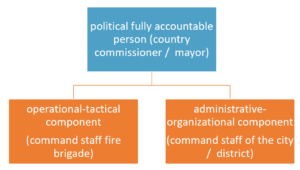
The operational-tactical components lead all units of the public danger defense. In addition to the chief of staff / incident commander, the sifter and situation-dependent expert advisors and liaison officers, it consists of the so-called S-functions, which assume a wide variety of tasks:
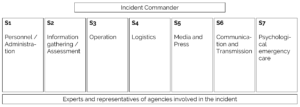
In the event of a disaster, the district administrator/mayor is the original head of operations and can therefore lead operations from his or her position. However, most political officials are aware that other people are more suitable for these tasks, which is why the command of operations is often handed over to a corresponding head of operations or the chief of staff. As a result, the overall political officer usually provides only broad strategies (e.g., “The top priority is to protect human life”). Subordinate to the command staff are then further sections with units that are led.
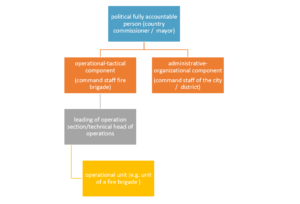
The administrative-organizational components are responsible for all areas that do not belong to hazard prevention authorities (mnemonic: everything that does not have a blue light on the roof). This crisis team is structured according to the departmental principle and is actually chaired by the mayor/county council.
| functions of the crisis team |
|
– head – internal service – situation and documentation |
|
– general administration – finance office – pupblic order office – public health department – environment and social affairs – liaison members of the fire department and police |
|
In the area of companies, there is usually no such separation, unless there is a plant fire brigade. The so-called emergency response team is often also structured according to the department principle. It is important to note that the managing director is usually the head of operations and always has the final decision-making authority, as long as this is not regulated otherwise. In other words, he or she is the crisis manager and head of staff as long as no other arrangements exist. An appointed crisis manager can either be given permanent operational leadership (then also head of the staff) or only be in charge until the management takes over. There is no standard solution for the structure of a crisis team or emergency response team and it must therefore always be designed according to the requirements of the company. A possible structure could be:
| Functions of the crisis unit/emergency response team |
|
|
|
|
|
|
|
|
|

In the event of an incident, this crisis team is subordinate to other smaller response teams that are responsible for specific tasks. These smaller teams, such as an IT emergency team, can also be set up in a staff structure and alerted individually. Because if there is no crisis or disaster, but “only” an emergency to manage, these teams can mostly act independently without having to ramp up a full escalation level, which increases overall efficiency.
Crisis management differs from emergency management in that there is no extensive pre-planning for crises or disasters. Therefore, no schemes can be purely worked off and the success of measures is also not guaranteed. Therefore, a staff must work together to develop solutions and implement necessary measures, which is why the multitude of competencies represented by the staff positions are necessary. There is no difference in the basic approach to staff work in the areas of public authorities and companies! A widespread thesis is that a well-trained team is able to cope with any problem adequately, regardless of the technical background. It is therefore purely a question of the method of coping. Thus, theoretically, a company’s crisis team could also handle a flood and would do a good job if properly trained. What is important is that certain principles are observed. Such principles could be:
- Apply management cycle/PDCA cycle.
- Effective communication
- Sufficiently explore the situation (obtain, assess, understand and share information)
- Establish priorities
- Understand own role and that of the staff
- Adequately set up leadership structures
- Anticipating the course of events/thinking ahead
- Documentation
- Division of tasks
- Orders instead of commands
- Checking actions for efficiency and time requirements
- Parallel actions and alternative planning
- Checking the actions taken
- Make clear and timely decisions
- Regular practice

It is important that the personnel deployed have important crisis management competencies (which of course also include purely technical knowledge) and are not selected for hierarchical reasons. People in crisis management must be able to quickly analyze and evaluate situations and options for action, make decisions and consider consequences. Self-profiling is out of place in a crisis situation, which is why individuals with “lower rank” and appropriate expertise are often more suitable than entities from top management. However, appropriate personnel must of course be equipped with the necessary authority or become event-specific.
There are many more differences and similarities in leadership when BCM and regulatory crisis management are considered. But this paper is intended to serve as an example and provide an overview. It is clear, however, that crisis management is always a particular challenge for which it is important to be prepared. After all, once a crisis has occurred, a functioning crisis management system cannot be conjured out of a hat. It requires extensive planning and exercises. Only in this way can a company or an authority become capable of acting and resilient in the face of emergencies, crises or disasters.
An article written by Jan Bäumer, published on 14 January 2019
Translated by Charlotte Ley

